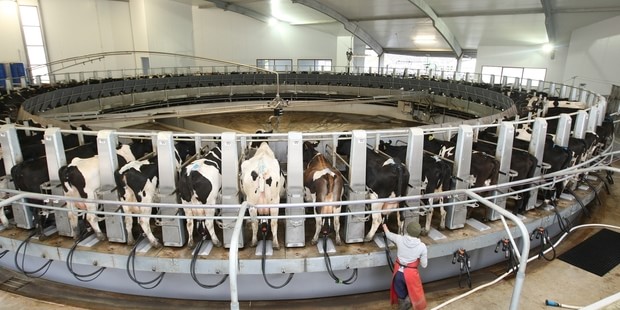Source: Dairy NZ
Good grass growth, high production and a record payout will see many of New Zealand’s dairy farmers look back on the 2013-2014 season as one of the best in history – and now the statistics prove it.
The New Zealand Dairy Statistics 2013-14, released by LIC and DairyNZ today, show the country’s 4.92 million cows achieved a new record in milk production, surpassing 20 billion litres in the 2013/2014 season. The milk contained 1.83 billion kilograms of milk solids, worth $15.5 billion with the season’s $8.47 average dairy payout.
DairyNZ senior economist Matthew Newman says the past season’s record milk production and prices have helped put farmers in a better position to cope with the rapid decline in milk prices this season.
“Sixty-five per cent of the increase in milk production last season came from the North Island, following the drought in 2012-13, so the increase reflects greater production of milksolids per cow up 30 kilograms to 357 Kg MS/cow. In the South Island there has been new milk in the industry from extra cows (+103,000).
“It has all added up to a great combination for farmers – the best season many can recall. We had good pasture growth, a high payout and farmers responded by making the most of the opportunity to produce a lot more milk.”
Across the country, the national herd grew by 138,600 cows (2.9%) and production from each cow was up 7.2%. Genetic merit also improved, with the average cow’s breeding worth (BW) and production worth (PW) increasing 14% and 10% respectively.
BW and PW measure profitability of livestock, to help farmers identify their best animals and the best genetics to mate their herd.
Dr Steve Harcourt, LIC commercialisation and industry relations manager, says the statistics confirm the progressive attitudes of New Zealand dairy farmers and the value of good genetics to improve productivity and prosperity.
“It’s no accident that the increasing trend of production correlates to the increase in Breeding Worth.
“Around three-quarters of the national herd are sired by an LIC bull. They are bred to deliver high quality offspring that will perform and produce in New Zealand conditions, with each generation bred to be better than the last.
“Combined with the proactive attitudes of farmers, their willingness to adopt new solutions that drive efficiency gains on-farm and their ongoing commitment to the fundamentals of herd improvement – that’s what has delivered this season’s great results.”
Dr Harcourt believes “it’s those attitudes that will help farmers get through this season with the lower payout, and continue to set new benchmarks in the future.”
The New Zealand Dairy Statistics document provides a review of the industry for the 2013-14 season, with statistics from the LIC database, Animal Evaluation database, NZ dairy companies, TBfree New Zealand, NZ Real Estate Institute and Statistics New Zealand.
The Dairy Statistics represent all New Zealand dairy farmers and include cow production and population, operating structures, breed breakdown, herd testing, artificial breeding, calving, milk prices, land prices and disease control.
Production
- Dairy companies processed 20.7 billion litres of milk containing 1.83 billion kilograms of milksolids
- 10.1% increase in milksolids processed
- Production per cow increased by 7.2% to an average of 371kg milksolids (comprising 210kg milkfat and 161kg protein)
- Average milksolids per cow was 371kg, compared with 346kg last season
- Average milk production per hectare was 1,063kg, well above last season’s 988kg
Cow numbers
- Cow numbers increased by 138,600 to 4.92 million cows, an increase of 2.9%
- Total number of herds increased by 36 to 11,927
- Average herd size was 413, up 11 cows on the previous season
- 12% of herds have 750+ cows
- A little over 50% (6,243) of herds have 100-349 cows
Operating structures
- 65% of all herds are operated as owner-operators
- 54% of all sharemilkers are on 50/50 contracts
Breed category
- Holstein-Friesian is the prevalent breed category in Northland, Bay of Plenty/East Coast and Manawatu/Wairarapa
- Holstein-Friesian/Jersey crossbreed is the prevalent breed category in Waikato, Taranaki and South Island regions
- Tasman/West Coast has the highest proportion of Jerseys (19%) followed by Taranaki (18%)
Herd testing and Artificial breeding (AB)
- 3.29 million cows were herd-tested, down on the previous two seasons
- A record 3.6 million cows to AB
- The number of yearlings to AB increased to 226,800, from 198,700
Herd Reproduction
- Herds with detailed Fertility Focus Reports, from early aged pregnancy testing, increased to 3,170
- 50% of herds had an actual 6-week in-calf rate of 67% or higher, 10% had an in-calf rate of 75% or higher
- 10% of herds had an in-calf rate of 55% or lower
Regional highlights
- 74% of dairy herds located in North Island
- 61% of dairy cows located in the North Island
- 58% of the milk produced in the North Island
- Largest average herd size (815) in North Canterbury
- South Island average herd sizes increasing faster than North Island




